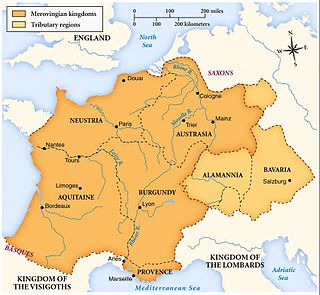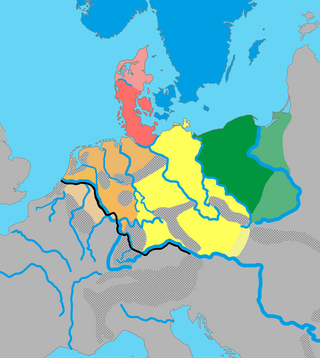Related Research Articles

The Merovingian dynasty was the ruling family of the Franks from the middle of the 5th century until 751. They first appear as "Kings of the Franks" in the Roman army of northern Gaul. By 509 they had united all the Franks and northern Gallo-Romans under their rule. They conquered most of Gaul, defeating the Visigoths (507) and the Burgundians (534), and also extended their rule into Raetia (537). In Germania, the Alemanni, Bavarii and Saxons accepted their lordship. The Merovingian realm was the largest and most powerful of the states of western Europe following the breaking up of the empire of Theodoric the Great.

The Salic law, also called the Salian law, was the ancient Frankish civil law code compiled around AD 500 by the first Frankish King, Clovis. The written text is in Latin and contains some of the earliest known instances of Old Dutch. It remained the basis of Frankish law throughout the early Medieval period, and influenced future European legal systems. The best-known tenet of the old law is the principle of exclusion of women from inheritance of thrones, fiefs, and other property. The Salic laws were arbitrated by a committee appointed and empowered by the King of the Franks. Dozens of manuscripts dating from the sixth to eighth centuries and three emendations as late as the ninth century have survived.
Primogeniture ( ) is the right, by law or custom, of the firstborn legitimate child to inherit the parent's entire or main estate in preference to shared inheritance among all or some children, any illegitimate child or any collateral relative. In most contexts, it means the inheritance of the firstborn son ; it can also mean by the firstborn daughter, or firstborn child.

Francia, also called the Kingdom of the Franks, Frankish Kingdom, Frankland or Frankish Empire, was the largest post-Roman barbarian kingdom in Western Europe. It was ruled by the Frankish Merovingian and Carolingian dynasties during the Early Middle Ages. Francia was among the last surviving Germanic kingdoms from the Migration Period era.

The Istvaeones were a Germanic group of tribes living near the banks of the Rhine during the Roman Empire which reportedly shared a common culture and origin. The Istaevones were contrasted to neighbouring groups, the Ingaevones on the North Sea coast, and the Herminones, living inland of these groups.

The Salian Franks, also called the Salians, were a northwestern subgroup of the early Franks who appear in the historical record in the fourth and fifth centuries. They lived west of the Lower Rhine in what was then the Roman Empire and today the Netherlands and Belgium.

Ripuarian or Rhineland Franks were one of the two main groupings of early Frankish people, and specifically it was the name eventually applied to the tribes who settled in the old Roman territory of the Ubii, with its capital at Cologne on the Rhine river in modern Germany. Their western neighbours were the Salii, or "Salian Franks", who were named already in late Roman records, and settled with imperial permission within the Roman Empire in what is today the southern part of the Netherlands, and Belgium, and later expanded their influence into the northern part of France above the Loire river, creating the Frankish empire of Francia.

Frankish, also known as Old Franconian or Old Frankish, was the West Germanic language spoken by the Franks from the 5th to 9th century.

The legal rights of women refers to the social and human rights of women. One of the first women's rights declarations was the Declaration of Sentiments. The dependent position of women in early law is proved by the evidence of most ancient systems.

The Chamavi, Chamãves or Chamaboe (Χαμαβοί) were a Germanic tribe of Roman imperial times whose name survived into the Early Middle Ages. They first appear under that name in the 1st century AD Germania of Tacitus as a Germanic tribe that lived to the north of the Lower Rhine. Their name probably survives in the region today called Hamaland, which is in the Gelderland province of the Netherlands, between the IJssel and Ems rivers.

The Franks were a Germanic people who were first mentioned by name in 3rd-century Roman sources, living near the Lower Rhine, on the northern frontier of the Roman Empire. Later, Romanized Frankish dynasties based within the collapsing Western Roman Empire became the rulers of the whole region between the rivers Loire and Rhine. They subsequently imposed power over many other post-Roman kingdoms both inside and outside the old empire. Beginning with Charlemagne in 800, Frankish rulers were given recognition by the Catholic Church as successors to the old emperors.

The Edictum Rothari was the first written compilation of Lombard law, codified and promulgated on 22 November 643 by King Rothari in Pavia by a gairethinx, an assembly of the army. According to Paul the Deacon, the 8th century Lombard historian, the custom law of the Lombards had been held in memory before this. The Edict, recorded in Vulgar Latin, comprised primarily the Germanic custom law of the Lombards, with some modifications to limit the power of feudal rulers and strengthen the authority of the king. Although the edict has been drafted in Latin, a few Lombard words were left untranslated, such as "grabworfin, arga, sculdhais, morgingab, metfio, federfio, mahrworfin, launegild, thinx, waregang, gastald, mundius, angargathung, fara, walupaus, gairethinx, aldius, actugild or, wegworin".
In the law of the Middle Ages and early Modern Period and especially within the Holy Roman Empire, an allod, also allodial land or allodium, is an estate in land over which the allodial landowner (allodiary) had full ownership and right of alienation.
The Lex Ripuaria, also spelled Lex Ribuaria, is a 7th-century collection of Germanic law, the laws of the Ripuarian Franks. It is a major influence on the Lex Saxonum of AD 802. The Lex Ripuaria originated about 630 around Cologne and has been described as a later development of the Frankish laws known from Lex Salica.
The pagan religion of the Germanic tribal confederation of the Franks has been traced from its roots in polytheistic Germanic paganism through to the incorporation of Greco-Roman components in the Early Middle Ages. This religion flourished among the Franks until the conversion of the Merovingian king Clovis I to Nicene Christianity, though there were many Frankish Christians before that. After Clovis I, Frankish paganism was gradually replaced by the process of Christianisation, but there were still pagans in the late 7th century.

Silva Carbonaria, the "charcoal forest", was the dense old-growth forest of beech and oak that formed a natural boundary during the Late Iron Age through Roman times into the Early Middle Ages across what is now western Wallonia. The Silva Carbonaria was a vast forest that stretched from the rivers Zenne and the Dijle in the north to the Sambre in the south. Its northern outliers reached the then marshy site of modern Brussels.

Women in the Middle Ages in Europe occupied a number of different social roles. Women held the positions of wife, mother, peasant, artisan, and nun, as well as some important leadership roles, such as abbess or queen regnant. The very concept of women changed in a number of ways during the Middle Ages, and several forces influenced women's roles during this period, while also expanding upon their traditional roles in society and the economy. Whether or not they were powerful or stayed back to take care of their homes, they still played an important role in society whether they were saints, nobles, peasants, or nuns. Due to context from recent years leading to the reconceptualization of women during this time period, many of their roles were overshadowed by the work of men. Although it is prevalent that women participated in church and helping at home, they did much more to influence the Middle Ages.

Germanic law is a scholarly term used to describe a series of commonalities between the various law codes of the early Germanic peoples. These were compared with statements in Tacitus and Caesar as well as with high and late medieval law codes from Germany and Scandinavia. Until the 1950s, these commonalities were held to be the result of a distinct Germanic legal culture. Scholarship since then has questioned this premise and argued that many "Germanic" features instead derive from provincial Roman law. Although most scholars no longer hold that Germanic law was a distinct legal system, some still argue for the retention of the term and for the potential that some aspects of the Leges in particular derive from a Germanic culture.
Salique may refer to:
References
- ↑ Drew, Katherine Fischer (1991). The Laws of the Salian Franks. University of Pennsylvania Press. pp. 44–45. ISBN 978-0-8122-1322-5 . Retrieved 25 November 2019.